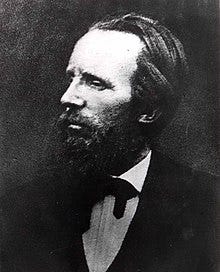An analysis of German pessimist Julius Bahnsens (1830-1881) theory of dialectics, conception of tragedy and its relation to the pessimistic worldview.
Introductory Remarks
Julius Bahnsen is often remembered as a disciple of the sage of Frankfurt, Arthur Schopenhauer, who attempted to supposedly “synthesize” the tragic worldview of Schopenhauer and the Hegelian dialectic of abstract-negative-concrete (I will use Fichtean terminology of thesis-antithesis-synthesis in relation to the dialectic from this point onward for the sake of simplicity), a move Schopenhauer would be enraged by. However, this interpretation is not entirely accurate and remains a simplification as Bahnsen was a highly original thinker and transcended and diverged from his main two influences (Hegel & Schopenhauer).
Will, Contradiction & Dialectic
His perspective of the world is derived from a single bleak vision: that the essentia of reality lies in the inner and irresolvable conflict of the will which is the source of all suffering, this, lays the foundations for a tragic worldview. agreeing with Schopenhauer on the world as will, albeit viewing the will as not one monolithic entity, but rather seeing it as that which individuates and attributing a manifold character just as the individuals which it constitutes. Following this line of reasoning and the introduction of the dialectical character of his thought in the constant clash of different wills, however, the Bahnsenian twist on the Hegelian dialectic lies in his rejection of the third step, that is, the synthesis which mirrors Jacques Lacans conception of the dialectic as lacking a synthesis. Where Lacan and Bahnsen diverge, however, lies in the after.
For Lacan, there is no end. it is an endless process which mirrors the presocratic Heraclitus. However, for Bahnsen, there is an end and that end is annihilation. The dialectic rather than having an ultimately affirmative character through negation, is left alone in its annihilative whole (whole to be understood as not a perfect totality, but rather as lacking something), lacking all teleological powers and any semblance of a grand, universal progress. Deleuze in Nietzsche & Philosophy demonstrated that ‘reactive forces’ lead to their own self-critique, their own self-destruction; this insight is similar to Bahnsen in a crude way, the difference however lies in the fact that instead of the reactive forces becoming-active, the end of the dialectical process lies in its own self-destruction with the death of both the synthesis and the antithesis, non-being taking their place.
The Radicality of his Pessimism
Among the pessimists of that fruitful period (1860-191?) of the popularity of the Schopenhauerian doctrine and pessimism, which enriched not only pessimist thought but also the opponents of pessimism, mainly neo-kantians and the positivists who developed their doctrines partially in reaction to Schopenhauer and his revival of metaphysics, Bahnsen was one of the most, or even the most radical. For the old sage of Frankfurt and the young Friedrich Nietzsche (in the birth of tragedy), art, and especially tragic art was seen as a way to redemption even though they took it in different directions. At one hand, Schopenhauer saw the suppression of the Dionysian life instincts (= the will) and the self-realization of the rationality of the Apollonian (= the intellect) as a redemptive experience, while for Nietzsche it was the opposite, i.e a passionate embrace of the Dionysian and the primordial unity as a way to redemption.
Von Hartmann saw redemption as the eventual passionate embrace of nothingness through historical progress culminating in the Prussian state (this optimistic outlook on history can be seen as what he took from Hegel in contrast to Bahnsen the dialectician).
Two figures have been ignored so far, Bahnsen himself and his contemporary Phillip Mainländer. These two were the most radical in their pessimism in the already radical age of Weltschmerz. Bahnsen can be seen as more radical than everyone else mentioned so far (Schopenhauer, Hartmann, Nietzsche) as he rejects the possibility of any and all redemption (one might object and say he viewed comedic laughter as redemptive even though I would disagree). Mainländer, however, was undoubtedly the most radical of the ‘redemptive pessimists’ as he saw redemption solely in death, fueled by the doctrine of the will-to-annihilation, the will to death which for him is both the liberation from hell and this will is illuminated by all world religions in state of purity which is destorted under the influence of clergy men who preach the will-to-live, thus the twofold character of a will who desires both preservation and annihilation (this insight might seem similar to the dialectics of Eros and Thanatos proposed by Freud although there is no evidence of Freud ever actively reading Mainländer) is that the will-to-annihilation is the natural one and that the desire for self-preservation and life are socially conditioned and in the end hold an artificial character. Now, I will let the reader to decide who is the more radical, Mainländer or Bahnsen?
Conclusion
Firstly thank you so much for reading this little text, hope you enjoyed it and finally this is the first in many posts on Bahnsen & German pessimism I plan to write.
Sources & Further Reading
Weltschmerz by Frederick C. Beiser
Julius Bahnsen by Harry Slochower
The Philosophy of Redemption by Phillip Mainländer
Nietzsche & Philosophy by Gilles Deleuze
The Birth of Tragedy by Friedrich Nietzsche
The World as Will and representation by Arthur Schopenhauer
Fragments by Heraclitus
Some Reflections on the Ego by Jaques Lacan




YES!!! Amazing!!